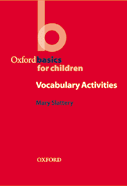September 2005 — Volume 9, Number 2
Vocabulary Activities
|
|||
| Author: | Mary Slattery (2004) | > |
|
| Publisher: | Oxford: Oxford University Press | ||
| Pages | ISBN | Price | |
|---|---|---|---|
| Pp. 72 | ISBN 019-4421953 (paper) | £3.95 | |
Vocabulary Activities is designed as a resource book for the teaching of English vocabulary to very young and young second-language learners. The term “very young learners” refers to children under the age of seven, while the term “young learners” designates children between the ages of seven and twelve. The activities are designed in accordance with the theory that children in these two age groups instinctively apply the skills they develop in their first language acquisition to their second language learning. In this view, children are regarded as “natural” learners, who bring to their learning many vital qualities such as curiosity, energy, and spontaneity. This implies that learning activities for children must be suited to their stage of mental development, a principle that is evident in the way the materials in the book are organized: there are separate sets of activities for the two age groups in question.
The activities for very young learners are based on the theory that very young children acquire language by watching, listening, doing things, and imitating. In other words, vocabulary acquisition takes place through active learning. One way that very young children absorb information is by looking at things. Thus, visual aids play a major role in the activities. They are used to establish and clarify meaning, provide an immediate memory association, and assist in the recall of words and phrases. The authors strongly encourage the use of real objects (activities 2 and 7) and picture cards (activities 4, 5, and 9). Another avenue through which very young children acquire their first-language is listening. The authors attempt to use this avenue in second-language learning by encouraging the teacher to do a lot of talking in class. The more the teacher talks, the more vocabulary the children pick up. For maximum effectiveness, such “teacher talk” can be carried out in the form of verbal interaction between the teacher and hand puppets or toys (activities 2, 4 and 9). A third means by which children acquire language (and vocabulary) is the performing of actions. Thus, some of the activities in the book incorporate movements and actions. The actions are usually an accompaniment to a rhyme-based or contextualized vocabulary, such as a rhyme for tidying up (activity 6), a rhyme for movement (activity 8), and a rhyme for body parts (activity 10). Finally, very young children have an enormous facility for imitation and acquire vocabulary in their first language by mimicking the sounds they hear. In recognition of this fact, the authors place great emphasis on the correct pronunciation of English sounds and on word stress.
The activities are divided into two sections: the first consists of ten activities for very young learners; the second contains fifteen activities for young learners. In the first section, the activities cover a variety of lexical themes such as color names (activity 3), food and drink (activity 4), transportation (activity 5), cookery (activity 7), animals (activity 9), and parts of the body (activity 10). The activities in the second section are geared to learners who can read and write, and are designed to get the children actively involved in their own learning process. Many activities require the learners to make sense of a situation or interpret nonverbal clues. In these activities, vocabulary acquisition is achieved by means of a repetition of patterns such as phrases and rhymes accompanied by actions (activities 11, 14, and 17). An additional strategy is the use of word games such as Bingo (activity 20), Dominoes (activity 22), word puzzles (activity 23), and crosswords (activity 24). For a more performative approach to vocabulary acquisition, the authors employ the technique of storytelling (activity 25). In this section, teacher talk is presented through various language functions: giving instructions (activity 14), giving explanations (activities 12, 16, and 21), providing descriptions (activities 13 and 17), asking questions (activity 18), and reciting rhymes (activity 17). In addition to the lexical themes used in the first section, this section includes themes such as room and furniture (activity 19) and occupations (activity 20).
The activities in this book progress from those suitable for very young learners to those that are within the capabilities of young learners. The activities for very young learners teach vocabulary through play and movement, whereas those for young learners involve a greater degree of participatory learning. The activities are based not only on psychological principles (retention, stage of development, and self-confidence), but also on educational theories (active learning, behavioral learning, and skill-based learning). Some of the innovative techniques that are used are visual aids, teacher talk, sound imitation, and storytelling activities.
Vocabulary Activities is an excellent resource for ESL teachers who are working with very young and young learners. Its greatest strengths are that it encourages children to get actively involved in their own learning process, it presents well-designed lesson plans, it provides detailed step-by-step instructions for conducting the activities, and it includes clear examples. This book demonstrates that learning can be both enjoyable and meaningful, and it is, therefore, highly recommended.
Wiroj Kosolritthichai
Laboratoire LIDILEM, Université Stendhal Grenoble 3 (France)
<wirojko yahoo.com>
yahoo.com>
|
© Copyright rests with authors. Please cite TESL-EJ appropriately. Editor’s Note: The HTML version contains no page numbers. Please use the PDF version of this article for citations. |

